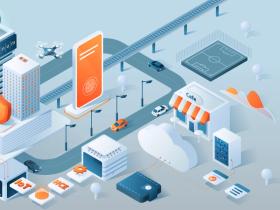Custom Software Development for Manufacturing Company: How to Build and How It Helps
Published: May 2, 2022
13 min read
In this article, you'll learn:
1
👍 Why Companies Invest to Build a Custom Manufacturing Software?
2
👨💻 Сustom Manufacturing Software Development vs Ready-Made Tools
3
🗂 Manufacturing Software Сases: What Can It Do?
4
💡 Takeaways
However, the real reason why more and more companies build custom manufacturing software is not that they’re participating in a made-up competition. Actually, it provides them with many benefits on different levels.
Let’s take a closer look!
👍 Why Companies Invest to Build a Custom Manufacturing Software?
Manufacturing companies use custom software for a wide range of different purposes. If we try to describe it with one sentence,
companies develop software for the manufacturing industry to enhance existing processes and introduce new ones
For example:
The advantage of custom software development and lean manufacturing is that it’s applicable in many cases. It also works for both digital novices and companies that have already implemented some digital practices. Eventually, it provides businesses with the following benefits:
- Companies can increase their revenue and reduce expenses by increasing their overall efficiency.
- Business owners and managers can access all the data in real-time. It empowers them to make proactive decisions and easily spot any changes or errors.
- Automate routine tasks to free a lot of time for your employees. Instead, they’ll be able to focus on something really important.
- Lower or eliminate human errors with the help of sensors, devices, AI and ML-algorithms.
- Avoid bottlenecks and effectively deal with unforeseen situations.
But is there an actual need to create custom software for a manufacturing company instead of using a ready-made solution? Let’s take a look at both cases!
👨💻 Сustom Manufacturing Software Development vs Ready-Made Tools
Let’s start with the key idea of this paragraph:
Different approaches fit different cases and needs.
Thus, we won’t try to convince you that custom software development and lean manufacturing is always better than using SaaS (software as a service; on-demand software) or vice versa.
Instead, let’s see how different they are and what the best cases for each approach are.
🚀 Scalability
How does a solution match your business needs?
There are many reasons why you may want to develop software for the manufacturing industry. For example, to manage relationships with your customers, get better control and transparency over your warehouse, make calculations, or improve the logistics system.
At this stage, we usually provide our readers with a description of typical features to include and some tips on how to do it better. However, the number of possible apps in this industry is huge.
Depending on whether you’d like to make custom software for manufacturing and tracking, or planning and scheduling, managing your warehouse, the list of key features will greatly change. Thus, we’ll review a few cases from different fields to show what types of manufacturing software you can build.
Let’s see!
🗂 Manufacturing Software Сases: What Can It Do?
Enterprise Resource Planning (ERP) System 🗃
ERP System is one of the most complex and comprehensive solutions. This is the digital heart of your company — a platform that allows you to collect and view data from different departments as well as manage their work.
It may consist of different parts like:
- inventory management tools;
- planning & scheduling functionality;
- production management system;
- employees management panel;
- tracking & logistics tools;
- QA and other systems.
You may think of ERP software for the manufacturing industry as a platform that lets you access and manage this data in a nice visual form. However, the parts of the ERP System may work well as separate applications.
Other few concepts that you'll meet when reading about industrial automation software development are:
These were a few examples of features that can be either a part of your ERP or make up a standalone app. If you have an idea of an app that would help your manufacturing business but you aren't sure about its costs and feasibility — drop us a line and we'll see how we can help!
💡 Takeaways
Moreover, this process is extremely flexible: you may develop software to deal with a very specific problem or create a big ERP platform to digitize all key processes in your company; at the same time, you may add new features to the existing system one by one, when you need them.
The software can help directly increase your profit by optimizing and speeding up production as well as improving the productivity of both employees and machinery. It also reduces your expenses that occur due to bottlenecks, wasted working hours of your employees or misplaced assets.
To make custom software for a manufacturing company you’ll need to find and hire a development team. This is how the process looks in short:
Was it helpful?
Read also

What is Prototyping in IoT and Some Practical Advice

What is IoT Device Management?

How to Make your React Native Application Accessible to ALL, not just to MANY
Our clients say
![Stormotion client Alexander Wolff, CPO from [object Object]](/static/a16ba3c9580effc3ab9a68d115eadffe/b0e74/alex.png)
When I was working with Stormotion, I forgot they were an external agency. They put such effort into my product it might as well have been their own. I’ve never worked with such a client-focused company before.
Alexander Wolff, CPO
Sjut
